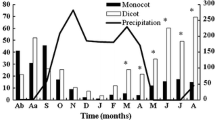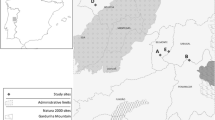Abstract
We evaluated the longevity of seeds of 12 common woody species buried in fresh condition in the forest floor at three forest locations in Mississippi and Louisiana. Seed samples of each species were retrieved annually for 5 years from each location. Germination and tetrazolium chloride staining tests were conducted on the samples to determine germinative capacity. When averaged across all species, seeds remained viable longer at the Alexandria, Louisiana site than at the two sites in Mississippi. Seeds of the 12 species varied widely in their response to burial. Some species, such as American beautyberry (Callicarpa americana L.), muscadine grape (Vitis rotundifolia Michx.), and sugarberry (Celtis laevigata Willd.), had relatively high germinative capacities (from 33 to 60 percent, depending on species) even after burial in the forest floor for 5 years, whereas other species, such as flowering dogwood (Cornus florida L.) and yaupon (Ilex vomitoria Ait.), had very low germinative capacities (less than 6 percent) by the end of the first year after burial. Species were classified into five groups based on their similarity of response.
Similar content being viewed by others
References
Association of Official Seed Analysts (1988) Rules for testing seeds. J Seed Technol 12:1–109
Bonner FT (1974a) Fraxinus Ash. In: Schopmeyer CS (Tech Coord) Seeds of woody plants in the United States. USDA Forest Serv., Washington, DC. Agric. Handb. 450 pp 411–416
Bonner FT (1974b) Ilex L. Holly. In: Schopmeyer CS (Tech Coord) Seeds of woody plants in the United States. USDA Forest Serv., Washington, DC. Agric. Handb. 450 pp 450–453
Bonner FT (1974c) Liquidambar styraciflua L. Sweetgum. In: Schopmeyer CS (Tech Coord) Seeds of woody plants in the United States. USDA Forest Serv., Washington, DC. Agric. Handb. 450 pp 505–507
Bonner FT, Crossley JA (1974) Vitis labrusca L. Fox grape. In: Schopmeyer CS (Tech Coord) Seeds of woody plants in the United States. USDA Forest Serv., Washington, DC. Agric. Handb. 450 pp 853–854
Bonner FT, Summerville KO (1999) Production and quality of Atlantic white-cedar seed in coastal North Carolina. In: Shear TH, Summerville KO (eds) Proceedings: Atlantic white-cedar: Ecology and Management Symposium. USDA Forest Serv., South. Res. Sta., Asheville, North Carolina. Gen. Tech. Rep. SRS-27 pp 76–79
Bonner FT, Vozzo JA, Elam WW, Land SB Jr. (1994) Tree seed technology training course. Instructorȁ9s manual. USDA Forest Serv., South. Forest Exp. Sta., New Orleans, Louisiana. Gen. Tech. Rep. SO-106. 160 p
Brinkman KA (1974a) Cornus L. Dogwood. In: Schopmeyer CS (Tech Coord) Seeds of woody plants in the United States. USDA Forest Serv., Washington, DC. Agric. Handb. 450 pp 336–342
Brinkman KA (1974b) Rhus L. Sumac. In: Schopmeyer CS (Tech Coord) Seeds of woody plants in the United States. USDA Forest Serv., Washington, DC. Agric. Handb. 450 pp 715–719
Hanlon TJ, Williams CE, Moriarity WJ (1998) Species composition of soil seed banks of Allegheny Plateau riparian forests. J Torrey Bot Soc 125:199–215
Haywood JD (1994) Seed viability of selected tree, shrub, and vine species stored in the field. New For 8:143–154
International Seed Testing Association (1985) International rules for seed testing. Seed Sci Technol 13:299–520
Kennedy HE Jr. (1990) Celtis laevigata Willd. Sugarberry. In: Burns RM, Honkala BH (Tech Coords) Silvics of North America, vol 2. Hardwoods. USDA Forest Serv., Washington, DC. Agric. Handb. 654 pp 258–261
Neter J, Wasserman W (1974) Applied linear statistical models. Richard D. Irwin, Inc., Homewood, Illinois, 842 p
Olson DF Jr, Gabriel WJ (1974) Acer L. Maple. In: Schopmeyer CS (Tech Coord) Seeds of woody plants in the United States. USDA Forest Serv., Washington, DC. Agric. Handb. 450 pp 187–194
Roberts TL, Vankat JL (1991) Floristics of a chronosequence corresponding to old field-deciduous forest succession in southwestern Ohio. II. Seed banks. Bull Torrey Bot Club 118:377–384
Rudolf PO, Phipps H (1974) Carpinus L. Hornbeam. In: Schopmeyer CS (Tech Coord) Seeds of woody plants in the United States. USDA Forest Serv., Washington, DC. Agric. Handb. 450 pp 266–268.
Schiffman PM, Johnson WC (1992) Sparse buried seed bank in a southern Appalachian oak forest: implications for succession. Am Midl Nat 127:258–267
Simpson RL, Leck MA, Parker VT (1989) Seed banks: general concepts and methodological issues. In: Leck MA, Parker VT, Simpson RL (eds) Ecology of soil seed banks. Academic Press, San Diego, pp 3–8
Tierney GL, Fahey TJ (1998) Soil seed bank dynamics of pin cherry in a northern hardwood forest, New Hampshire, USA. Can J For Res 28:1471–1480
Titus JH (1991) Seed bank of a hardwood floodplain swamp in Florida. Castanea 56:117–127
Wendel GW (1977) Longevity of black cherry, wild grape, and sassafras seed in the forest floor. USDA Forest Serv., Northeast. Forest Exp. Sta., Upper Darby, Pennsylvania. Res. Pap. NE-375. 6 p
Acknowledgments
We thank Marianne K. Burke, Wayne K. Clatterbuck, Kristina F. Connor, and two anonymous reviewers for their constructive comments on earlier drafts of this manuscript.
Author information
Authors and Affiliations
Corresponding author
Rights and permissions
About this article
Cite this article
Meadows, J.S., Bonner, F.T. & Haywood, J.D. Soil-Seed Bank Survival in Forests of the Southern United States. New Forests 32, 335–345 (2006). https://doi.org/10.1007/s11056-006-9007-6
Received:
Accepted:
Published:
Issue Date:
DOI: https://doi.org/10.1007/s11056-006-9007-6




